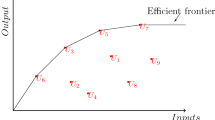Abstract
The purpose of this paper is to apply some novel features in the theory of productivity indexes to the measurement of productivity gaps. It advances the proposition that one reason for the persistence of productivity gaps might be that the methodology of measuring gaps does not separate shifts of the production function due to intercountry efficiency from shifts due to intercountry differences in capacity utilization.
In this paper we calculate productivity gaps for four OECD countries relative to the U.S., adjusted for cyclical variations in capacity utilization for the period 1963–1982. The theoretical foundation of our measurement is based on a variable cost function approach with short-run fixity of capital. Without adjusting for differences in capacity utilization within the countries, productivity gaps are a mixture of differences in productivity and in capacity utilization.
Similar content being viewed by others
References
Berndt, Ernst R., and Melvyn, Fuss. 1986. Productivity Measurement with Adjustments for Variations in Capacity Utilization and Other Forms of Temporary Equilibria. Journal of Econometrics 33:7–29.
Berndt, Ernst R., and Dieter, Hesse. 1986. Measuring and Assessing Capacity Utilization in the Manufacturing Sectors of Nine OECD Countries. European Economic Review 30:961–989.
Caves, D. W., L. R. Christensen, and W. E. Diewert. 1982. Multi-lateral comparisons of output, input and productivity using superlative index numbers. Economic Journal 92:73–86.
Christensen, L. R., D. Cummings, and D. W. Jorgenson. 1981. Relative Productivity Levels, 1947–1973: An International Comparison. European Economic Review 61–94.
Christensen, L. R., D. Cummings, and D. W. Jorgenson. 1980. Economic Growth, 1947–1973: An International Comparison. In J. W. Kendrick and B. Vaccara [ed.], New Developments in Productivity Measurement and Analysis. Studies in Income and Wealth 41:595–698. Chicago, University of Chicago Press.
Conrad, K., and D. W. Jorgenson. 1985. Sectoral Productivity Gaps between the United States, Japan, and Germany 1960–1979. In H. Giersch [ed.], Probleme und Perspektiven der weltwirtschaftlichen Entwicklung. Duncker & Humblot, Berlin.
Conrad, K. 1985. Produktivitätslücken nach Wirtschaftszweigen im internationalen Vergleich. Beschreibung und ökonometrische Ursachenanalyse für die USA, Japan, und die Bundesrepublik Deutschland, 1960–1979. Springer-Verlag, Heidelberg, New York.
Conrad, K. 1987. Theory and Measurement of Productivity and Cost Gaps: A Comparison for the Manufacturing Industry in U.S., Japan, and Germany, 1960–1979. In W. Eichhorn [ed.], Measurement in Economics 725–750. Würzburg, Physica Verlag.
Denny, M., M. Fuss, and J. D. May. 1981. Intertemporal Changes in Regional Productivity in Canadian Manufacturing. Canadian Journal of Economics 3:390–408.
Denny, M., and M. Fuss. 1983a. The Use of Discrete Variables in Superlative Index Number Comparisons. International Economic Review 24:419–421.
Denny, M., and M. Fuss. 1983b. A General Approach to Intertemporal and Interspacial Productivity Comparisons. Journal of Econometrics 23:315–330.
Denny, M., and M. Fuss. 1983c. Intertemporal Changes in the Levels of Regional Labor Productivity in Canadian Manufacturing. In A Dogramaci [ed.], Developments in Econometric Analysis of Productivity, Boston.
Diewert, W. E. 1976. Exact and superlative index numbers. Journal of Economics 115–145.
Hulten, C. R. 1986. Productivity Change, Capacity Utilization, and the Sources of Efficiency Growth. Journal of Econometrics 33:31–50.
Jorgenson, D. W., and M. Nishimizu. 1978. U.S. and Japanese Economic Growth, 1952–1974: An International Comparison. Economic Journal 88:707–726.
Kravis, I. B., A. Heston, and R. Summers. 1982. World Product and Income, International Comparisons of Real Gross Product (Baltimore and London).
Lau, L. J. 1979. On exact index numbers. The Review of Economics and Statistics 73–82.
Morrison, Catherine J. 1986a. Productivity Measurement with Nonstatic Expectations and Varying Capacity Utilization: An Integrated Approach. Journal of Econometrics 33:51–74.
Morrison, Catherine J. 1985b. Primal and Dual Capacity Utilization: An Application to Productivity Measurement in the U.S. Automobile Industry. Journal of Business and Economic Statistics 3:312–324.
Morrison, Catherine J. 1985c. Shadow Values, Capacity Utilization, and Productivity Measurement in U.S. and Japanese Manufacturing. NBR Working Paper, unpublished.
Nelson, R. R. 1981. Research on Productivity Growth and Productivity Differences: Dead ends and new departures. Journal of Economic Literature 19. Sept. 1981, 1029–1024.
Author information
Authors and Affiliations
Additional information
The refereeing process of this paper was handled through C. Morrison.
Rights and permissions
About this article
Cite this article
Conrad, K., Unger, R. Productivity gaps and capacity utilization in the manufacturing sectors of five OECD-countries, 1963–1982. J Prod Anal 1, 101–122 (1989). https://doi.org/10.1007/BF00157791
Issue Date:
DOI: https://doi.org/10.1007/BF00157791




